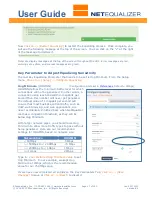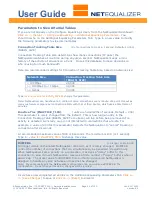
User Guide
APconnections, Inc. // 303.997.1300 // www.netequalizer.com
Page 22 of 120
rev. 20170131
© 2014-2017 APconnections, Inc. All Rights Reserved
version 8.4
Setting Bandwidth Limits
Bandwidth Limits can be set if you want to restrict the amount of bandwidth a specific IP
address or set of IP addresses can use. This is done through the use of
Bandwidth
Limiting Rules
to carve out maximum bandwidth usages for a particular subscriber base.
For example, a college network administrator may want to set up separate bandwidth usage
categories with bandwidth limits for each of three subnets: 1) students, 2) faculty, and 3)
administrators. This would be accomplished by using the "Pools" Bandwidth Limiting Rule,
which can be used to set up three separate Pools, each with their own bandwidth limit:
Pool1 = students 100Mbps up/120Mbps down
Pool2 = faculty 50Mbps up/60Mbps down
Pool3 = administrators 25Mbps up/30Mbps down
Bandwidth Limiting Rules define and restrict the amount of bandwidth a specific IP address
or set of IP addresses can use. Bandwidth Limits do NOT physically reserve bandwidth on
your network. They are used to set a virtual ceiling or limit for an IP or group of IPs. There
are multiple ways to configure this in the NetEqualizer, to best meet your needs. The
Bandwidth Limiting Rules are as follows, and will be discussed in detail below:
Bandwidth Limiting Rules
1.
Hard Limits by IP
- Individual limits by IP or subnet.
2.
Adding Bursting by IP
- Burst a Hard Limit by IP.
3.
Bandwidth Pools
- Shared limits by IP or subnet.
4.
VLAN Shared Limits
- Shared limits by VLAN.
Note: As Bandwidth Limiting Rules are allocations, not reservations, bandwidth is not set aside for
them. Rather, network bandwidth is available for use at all times.
















































